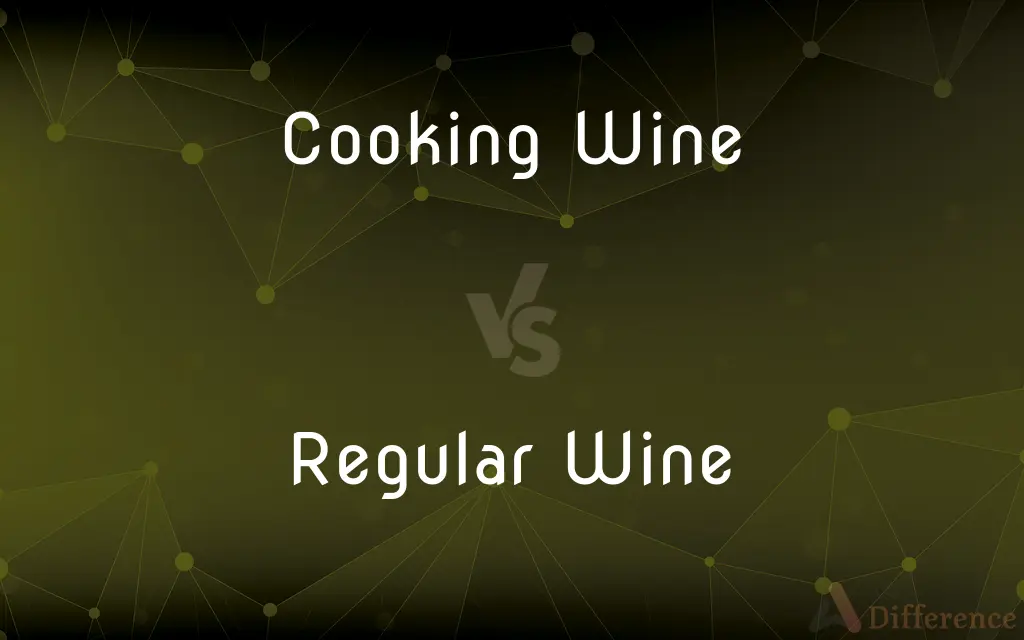Cooking Wine vs. Regular Wine — What's the Difference?
Edited by Tayyaba Rehman — By Fiza Rafique — Published on November 25, 2023
Cooking Wine is wine with added salt and seasonings for culinary use; Regular Wine is primarily for drinking, without additives.

Difference Between Cooking Wine and Regular Wine
Table of Contents
ADVERTISEMENT
Key Differences
Cooking Wine is a type of wine specifically formulated for use in culinary dishes. It often has added salts, seasonings, or even preservatives that enhance the flavor of dishes when cooked. On the other hand, Regular Wine is the type that most people are familiar with, meant primarily for drinking. It doesn't have the additives that Cooking Wine does, which allows for a purer wine taste when consumed.
Cooking Wine is often not as enjoyable to drink on its own due to its high salt content and added ingredients. In contrast, Regular Wine is crafted to be enjoyed as a standalone beverage, often accompanying meals or served at social gatherings. While Cooking Wine is tailored for the kitchen, Regular Wine takes center stage at the dinner table.
That being said, many chefs and culinary experts recommend using Regular Wine over Cooking Wine in recipes. The idea is that if a Regular Wine tastes good enough to drink, it will also enhance the flavor of the dish. Cooking Wine, because of its specific additives, might not always provide the desired taste in a dish compared to Regular Wine.
In terms of purchasing, Cooking Wine can often be found in the condiment or sauce aisle of grocery stores, while Regular Wine is typically located in dedicated wine or liquor sections. This distinction is a testament to the primary uses of both—Cooking Wine for culinary applications and Regular Wine for direct consumption.
In essence, while both Cooking Wine and Regular Wine have their places in the culinary world, they serve different primary purposes. Cooking Wine is a kitchen staple for many dishes, while Regular Wine is a beverage enjoyed by many either on its own or with a meal.
ADVERTISEMENT
Comparison Chart
Primary Use
Culinary dishes
Drinking
Additives
Often contains salt, seasonings, or preservatives
Usually without additives
Taste when consumed raw
Not ideal due to additives
Crafted to be enjoyable
Location in Stores
Condiment or sauce aisle
Wine or liquor section
Price Point
Generally cheaper
Can range from affordable to very expensive
Compare with Definitions
Cooking Wine
Wine formulated for culinary use.
I added some Cooking Wine to the sauce for extra flavor.
Regular Wine
Celebrated for its nuanced flavors and aromas.
This Regular Wine has notes of berry and oak.
Cooking Wine
Available in various varieties like red or white.
For this chicken recipe, a white Cooking Wine works best.
Regular Wine
Lacks the additives found in cooking versions.
This Regular Wine has a pure, fruity profile.
Cooking Wine
Enhances flavor in cooked dishes.
A splash of Cooking Wine can elevate a simple stir-fry.
Regular Wine
Often paired with meals or cheese.
A glass of Regular Wine goes wonderfully with a cheese platter.
Cooking Wine
Often contains added salt or seasonings.
This brand of Cooking Wine has a distinct herby note.
Regular Wine
Comes in various types like red, white, or rosé.
I prefer white Regular Wine with my seafood dishes.
Cooking Wine
Not typically enjoyed as a drinking beverage.
I accidentally took a sip of Cooking Wine and it was quite salty.
Regular Wine
Primarily produced for drinking.
I bought a bottle of Regular Wine for tonight's dinner.
Common Curiosities
Why is Cooking Wine not ideal for drinking?
It often has additives like salt and seasonings that affect its taste.
Is Regular Wine suitable for cooking?
Yes, many chefs recommend using Regular Wine over Cooking Wine for better flavor.
What's the main purpose of Cooking Wine?
Cooking Wine is designed primarily for culinary use in dishes.
Is it a faux pas to serve Cooking Wine as a drink?
Generally, yes, due to its altered taste from additives.
Does Cooking Wine have alcohol?
Yes, but it often cooks off during the cooking process.
Can I replace Cooking Wine with Regular Wine in a recipe?
Yes, and it might even enhance the dish's flavor.
What's the price difference between the two?
Cooking Wine is generally cheaper than Regular Wine.
Where can I find Cooking Wine in stores?
It's typically in the condiment or sauce aisle.
How long can I store an opened bottle of Regular Wine?
A few days to a week, but it's best enjoyed sooner.
Are there different varieties of Cooking Wine?
Yes, like Regular Wine, it comes in red, white, or other varieties.
Why do some recipes specify red or white wine?
Different wines offer unique flavors that can complement specific dishes.
Do both wines contain preservatives?
Cooking Wine often does, while Regular Wine might, depending on the brand.
Are there alcohol-free versions of Cooking Wine?
Yes, there are non-alcoholic substitutes available.
Which wine should I use for a wine reduction sauce?
Regular Wine is preferred for a more authentic flavor.
Can I use Cooking Wine for marinating meats?
Yes, it can impart flavor and help tenderize the meat.
Share Your Discovery

Previous Comparison
Badger vs. Honey Badger
Next Comparison
Head Chef vs. Executive ChefAuthor Spotlight
Written by
Fiza RafiqueFiza Rafique is a skilled content writer at AskDifference.com, where she meticulously refines and enhances written pieces. Drawing from her vast editorial expertise, Fiza ensures clarity, accuracy, and precision in every article. Passionate about language, she continually seeks to elevate the quality of content for readers worldwide.
Edited by
Tayyaba RehmanTayyaba Rehman is a distinguished writer, currently serving as a primary contributor to askdifference.com. As a researcher in semantics and etymology, Tayyaba's passion for the complexity of languages and their distinctions has found a perfect home on the platform. Tayyaba delves into the intricacies of language, distinguishing between commonly confused words and phrases, thereby providing clarity for readers worldwide.













































